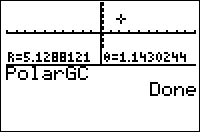TI-BASIC:Polargc
Command Summary
Sets the calculator to display point coordinates using polar coordinates.
Command Syntax
PolarGC
Menu Location
Press:
- 2nd FORMAT to access the graph format screen
- Use arrows and ENTER to select PolarGC.
TI-83/84/+/SE
2 bytes
The PolarGC ("Polar Grid Coordinates") command (like its opposite, the RectGC) command, affects how the coordinates of a point on the graph screen are displayed. When PolarGC is enabled, the coordinates of a point are displayed as (R,θ).
The polar coordinates of a point can be interpreted as the distance R it is away from the origin (0,0), and the direction θ. θ is the angle that a ray to the point would make with the positive X-axis (so polar coordinates are affected by Degree/Radian mode). An angle of 0 means the point is to the left of the origin; an angle of 90° (π/2 radians) means it's up from the origin, and so on. So, for example, the point with R=2 and θ=270° (3π/2 radians) would be two units down from the origin.
Of course, coordinates are only displayed with the CoordOn setting; however, with CoordOff, RectGC and PolarGC are still useful, because in a variety of cases, the coordinates of a point are also stored to variables. PolarGC doesn't change the fact that they're stored to X and Y, as with RectGC; however, with PolarGC, they are also stored to R and θ.
Although the PolarGC command naturally goes with Polar graphing mode, the two settings are independent; you can use both PolarGC and RectGC with any graphing mode.
Advanced
The following situations involve storing coordinates of a point to variables:
- Graphing an equation
- Tracing an equation or plot
- Moving the cursor on the graph screen
- Using the interactive mode of one of the 2nd DRAW commands
- Using one of DrawF, DrawInv, or Tangent(
- Anything in the 2nd CALC menu.
Naturally, any command like Input or Select( which involves the above, will also store coordinates of a point.
